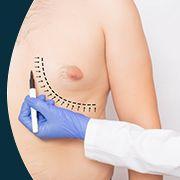How to Safely Remove a Lipoma Yourself: Risks and Guidelines
In This Article
How to Safely Remove a Lipoma Yourself: Risks and Guidelines
Ashitha Kareem
Updated on April 05, 2024
Medically verified by Dr. Arya
Fact checked by Dr. Pournami

Cosmetic
5 min read
Mykare Health is here to talk about why you might want to pump the brakes and think it over.
We get where you’re coming from and want to help you make the best choice. This blog explores the risks associated with self-removal of lipomas and emphasises the importance of professional medical advice.
What is a Lipoma?
A lipoma is a soft, movable lump under the skin, formed from an overgrowth of fat cells.
They are typically painless and grow over time. They are very common benign tumours of fatty tissues.
Understanding Lipoma
Lipomas are round, oval shaped movable fat deposits in adipose tissues. They are usually painless.
However, depending on their location the growth may cause discomfort and inconveniences.
Most cases they are harmless. But in rare cases the growth and pressure on vital regions or nerves may cause complications or even death.
When does lipoma become a concern
- Lipomas are usually painless. If you feel pain seek advice from a doctor.
- The size of the lipomas may be concerning. They can be treated with less scarring minimally invasive techniques.
- The location of lipomas can lead to complications of the disease. Lipomas pressing on nerves or joints can be uncomfortable and, at most, can be life-threatening.
Where can Lipomas appear
Most Lipomas occur under the skin
- Arms or legs
- Back
- Neck and shoulders
- Chest
- Forehead
Diagnosis
- Physical examination
- A tissue sample removed for lab examination/ Biopsy
- An X-ray or other imaging test, such as an MRI or CT scan
 9 min read
9 min readThe Advantages of Choosing Mykare Health for Gynecomastia Surgery
 6 min read
6 min readIdentifying The Ideal Age For Gynecomastia Surgery
 6 min read
6 min readPre and Post Gynecomastia Surgery: Essential Things to Know
Get a Callback Now
What Are The Medical Interventions of Lipoma Removal?
Most lipomas do not need to be removed unless they are painful or need formal diagnosis. Some are removed for aesthetic reasons.
Traditional open surgeries were used to remove lipomas. However, now there are newer, minimally invasive surgeries like liposuction, laser lipolysis, and endoscopic removal that results in lesser scarring and reduced recovery time.
Research is ongoing in using lipodissolve (or injection lipolysis) as a non surgical method to be widely practised for treating lipoma.
Treatments
- Open surgery
- Minimally invasive treatment
- Robotic or laser removal
Self Removal of Lipoma
- Special dietary supplements like antioxidants rich fruits ,omega 3 foods and ayurvedic leaves like triphala are said to have an impact in reducing the inflammation and growth of the lipoma.
- There is no proven medicine or scientifically proven dietary supplement for lipoma removal as of the moment.
- However you can use these supplementary suggestions to help keep your body fit and healthy.Surgical methods are, used to treat lipomas.
- People also attempt self-treating lipoma with needles. These can lead to more complications. It increases the chances of infection and scarring. And moreover there remains a possibility for misdiagnosis.
Why Do People Use Self- Medical Treatments?
Self medication is a global factor having a negative effect on people’s health.
Self-medication has traditionally been defined as “the taking of drugs, herbs or home remedies on one's own initiative, or on the advice of another person, without consulting a doctor.”
Rampant irrational self treatments without medical guidance may result in greater probability of inappropriate, incorrect, or undue therapy, missed diagnosis, delays in appropriate treatments.
Reasons for Increased Self Treatment
- Health care services are costlier
- Not enough health care facilities in developing countries
- Inconvenience in visiting a doctor
- Lack of time
- Ignorance and misbeliefs
- Extensive advertisements
- And Availability of drugs.
Why Professional Removal is Advised
Medical diagnosis and self treatment are not always a good choice. Especially surgeries being more prone to infections and complications . Self treatment may bring more harm than benefit.
Lipoma removal is a simple process and often with same day discharge. Professionals using sterile tools ensure the health and safety of the person.
Lipoma needs to be removed entirely to prevent regrowth. Self treatment leaves the risk of regeneration of the fat cells.
Lipomas are benign tumours. But self treatment increases the possibility of misdiagnosing a malignant tumour for lipomas. In some cases a lump resembling lipoma may actually be a form of cancer called liposarcoma.
The potential risks of not seeking professional medical care includes:
- Incorrect self-diagnosis
- Missing the most appropriate time of treatment
- Incorrect choice of therapy
- Failure to understand the red lights of the medications
Self treatments like exercise and a healthy diet may reduce your risk of getting lipomas.
But apart from the healing and reducing inflammation there is no scientific evidence reporting these home remedies having an effect in managing lipomas.
And feeling painless tender lump doesn’t prove the condition as lipoma.
So for our own health and safety purposes we should always consult a doctor for professional advice.
Consult with your doctor before trying the home remedies or self medication to avoid double medication or any other possible adverse effects.
Lipomas are soft, non-cancerous lumps of fat under the skin, often harmless.
They can be a concern if they are painful, large, or in uncomfortable spots.
Medical options include surgeries like liposuction or laser removal for less scarring.
Self-removal methods, like certain diets or home remedies, lack scientific backing and can be risky.
Always see a doctor for a proper diagnosis and safe removal to avoid complications.
Source Links
American Cancer Society
National Library of Medicine



